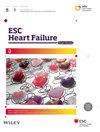Identification of serum C4BPA as a potential diagnostic marker of right ventricular remodelling via proteomic analysis
Abstract
Aims
Right ventricular (RV) remodelling, a progressive condition characterized by maladaptive cardiac structural and functional changes, primarily results from prolonged pressure overload in patients with pulmonary hypertension (PH). Accurate, universal and easy-to-use biomarkers for assessing the severity of RV remodelling are lacking. This study aimed to identify serum proteins as potential biomarkers of RV remodelling using high-throughput proteomic analysis-based screening.
Methods
Sprague–Dawley rats were subjected to sham surgery (control group) or pulmonary artery banding for 4 weeks with 2.3-mm diameter and 1.8-mm diameter rubber rings to induce mild and severe RV modelling, respectively. Serum proteomic profiling revealed 170 differentially expressed serum proteins (DEPs) among the three groups, and three DEPs gradually increased with worsening RV remodelling. Among the three DEPs, C4b-binding protein alpha chain (C4BPA) exhibited the highest upregulation in the severe group (6.93 vs. 16.5 ng/mL, P < 0.001), and linear regression analysis revealed a negative correlation between serum C4BPA levels and tricuspid annular plane systolic excursion (TAPSE) in rats [beta = −0.78, 95% confidence interval (CI) −14.5 to −7.11, P < 0.001]. The diagnostic power of C4BPA was further validated in 127 patients (34 with adaptive RV pressure overload, 36 with maladaptive RV pressure overload, 32 with left ventricular hypertrophy and 25 controls). Control and left ventricular hypertrophy patients exhibited lower serum C4BPA levels than the two RV groups, and serum C4BPA levels were higher in patients with maladaptive RV than in those with adaptive RV (754 vs. 524 pg/mL, P < 0.001). Linear regression analysis revealed a negative correlation between serum C4BPA levels and TAPSE in PH patients. The predictive power of C4BPA for maladaptive RV function in PH patients, indicated by receiver operating characteristic analysis (cut-off value 573 pg/mL, area under the curve 0.792), was as good as that of B-type natriuretic peptide (BNP). High serum C4BPA levels (≥573 pg/mL) were associated with lower TAPSE/pulmonary arterial systolic pressure ratios (P < 0.001) and higher BNP levels (P < 0.001).
Conclusions
Serum C4BPA may represent a novel diagnostic biomarker for RV pathological remodelling associated with RV maladaptation in PH patients.


 求助内容:
求助内容: 应助结果提醒方式:
应助结果提醒方式:


